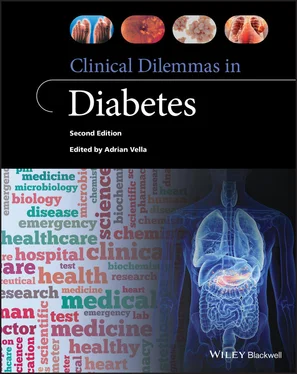Pooled data analysis of nine studies from five countries examined glycemic thresholds for diabetes‐specific retinopathy (defined as moderate or more severe retinopathy) in 44 623 subjects [57]. A curvilinear relationship was found to exist for FPG and HbA1c when diabetic retinopathy was plotted against continuous glycemic measures. Diabetes‐specific retinopathy began to increase from a FPG of 6.0–6.4 mmol/L and from a HbA1c of 6.0–6.4%. Based on vigintile distributions, glycemic thresholds for diabetes‐specific retinopathy were observed over the range of 6.4–6.8 mmol/L for FPG, 9.8–10.6 mmol/L for 2‐h PG, and 6.3–6.7% for HbA1C. Compared with the first vigintile, the odds ratios for diabetes‐specific retinopathy for the above vigintile distributions were 2.5 (95% CI 1.2–5.2) for FPG, 10.1 (95% CI 1.3–79.4) for 2 h PG, and 4.5 (95% CI 1.4–15.2) for HbA1c.
A major limitation of many studies that examine the prevalence of retinopathy is the diagnostic criteria used to define diabetes‐specific retinopathy [57]. The use of an overly broad definition for retinopathy leads to the inclusion of subjects with mild retinopathy, which may have etiologies other than hyperglycemia. Overall, the rate of retinopathy increases with the degree and duration of hyperglycemia [56, 57]. Subjects with prediabetes have a higher prevalence of retinopathy than subjects with NFG/NGT, although the prevalence remains relatively low. In many populations, the glycemic threshold for retinopathy occurs in the prediabetic range of dysglycemia [57, 58].
Analysis of NHANES data from 1999–2006 revealed that chronic kidney disease (CKD), defined as either reduced kidney function or elevated albuminuria (urinary albumin‐creatinine ratio ≥ 30 mg/g), was present in 17.1% of prediabetics compared to 11.8% of individuals with normoglycemia [59]. A multiethnic study found that 16.1% of subjects with IGT had microalbuminuria, compared to 4% of subjects with NGT [60]. After adjusting for multiple variables, glycemic status was found to be the most significant determinant of urinary albumin concentration. A systematic review and meta‐analysis including 9 studies with 185 452 subjects reported that prediabetes was modestly associated with an increased risk of CKD [61]. After adjusting for established risk factors, the relative risk of CKD was 1.11 (95% CI 1.02–1.21) for subjects with FPG between 6.1–6.9 mmol/L.
The prevalence and five‐year incidence of nephropathy increases as FPG, 2‐h PG, and HbA1c rise [12, 58]. Of note, the association of glycemia with nephropathy is weaker than the association between glycemia and retinopathy. When plotting prevalence of microalbuminuria against FPG, 2‐h PG, and HbA1c, there is a visible inflection point and subsequent increase in microalbuminuria prevalence beyond a FPG of 5.5 mmol/L, 2‐h PG of 5.5 mmol/L (and again at 9.3 mmol/L), and HbA1c of 5.8%. In summary, multiple studies suggest that prediabetic‐range hyperglycemia is associated with higher rates of nephropathy.
Although neural dysfunction is associated with hyperglycemia, clinicians should be mindful that neurologic deficits can be attributable to non‐glycemic causes in individuals with prediabetes and DM [62]. Subjects with isolated IGT were shown to have subclinical neural dysfunction that was generally asymptomatic and characterized by small‐fiber neuropathy and mild impairment of cardiovascular autonomic function [63]. Erectile dysfunction has also been shown to be independently associated with IFG, with an odds ratio of 1.26 (95% confidence interval 1.08–1.46) [64]. Prediabetic‐range hyperglycemia is also associated with chronic idiopathic axonal polyneuropathy (CIAP) [65]. In a study of 100 subjects with CIAP, 36 individuals were found to have IFG, 3 had FPG ≥ 126 mg/dL, 38 had IGT, and 24 had 2‐h PG ≥ 200 mg/dL. Overall, the prevalence of dysglycemia in this cohort was approximately 2‐fold higher than in an age‐matched general population group.
Macrovascular complications and mortality associated with prediabetes
There is an increased prevalence of cardiovascular disease (CVD) in individuals with prediabetes, but this relationship is confounded by common‐risk factors present in CVD and prediabetes [66–68]. However, after accounting for non‐glycemic cardiovascular risk factors, both IFG and IGT are still associated with a modestly increased risk of developing CVD. It is possible that much of this risk is due to the increased risk of ultimately progressing to DM.
Approximately 25% of first myocardial infarctions (MIs) are unrecognized, which are predictive of future major cardiovascular events including death [69]. In a multi‐ethnic population‐based cohort study adjusted for cardiovascular risk factors, it was shown that subjects with IFG have a higher prevalence of unrecognized MIs than those with NFG, with an odds ratio of 1.60 (95% CI 1.01–2.48).
In the Whitehall Study, after 5–10 years of follow‐up, survival by baseline glucose tolerance status diverged among the groups, and median survival differed by approximately 4 years between the normoglycemic and glucose intolerant groups [70]. Overall, all‐cause mortality, cardiovascular mortality, and respiratory mortality were higher among participants with glucose intolerance. The hazard of coronary mortality rose beginning at a 2‐h PG of 83 mg/dL; however, the graded relationship diminished after adjusting for multiple variables including baseline CVD.
A systematic review and meta‐analysis incorporated 53 prospective studies with 1 611 339 subjects who were followed for a median of 9.5 years for cardiovascular and mortality outcomes [68]. IFG and IGT diagnostic criteria were in accordance with 2020 ADA guidelines [1]. Compared to individuals with normoglycemia, those with IGT or IFG had an increased risk of composite CVD (relative risk (RR) 1.13 for IFG and 1.30 for IGT), coronary heart disease (RR 1.10 for IFG and 1.20 for IGT), stroke (RR 1.06 for IFG and 1.20 for IGT), and all‐cause mortality (RR 1.13 for IFG and 1.32 for IGT). One limitation of this systematic review and meta‐analysis is that some of the included studies did not adjust for progression to DM during the follow‐up period.
A separate meta‐analysis examined 102 prospective studies with 698 782 subjects and showed that FPG was modestly and non‐linearly associated with vascular disease, with hazard ratios for coronary heart disease of 1.11 for FPG of 5.6–6.09 mmol/L and 1.17 for FPG of 6.1–6.99 mmol/L [71]. Another meta‐analysis that included 97 prospective studies with 820 900 subjects calculated hazard ratios for cause‐specific death according to baseline FPG [72]. After adjusting for multiple variables and excluding subjects with known CVD at baseline, FPG was found to be nonlinearly related to risk of death. Compared with subjects with NFG, subjects with IFG had hazard ratios of 1.13 for cancer deaths, 1.17 for vascular deaths, and 1.12 for non‐cancer and non‐vascular deaths.
Management of prediabetes
The goals of prediabetes management include preserving β‐cell function, delaying or preventing the onset of DM, delaying or preventing the developing of microvascular and macrovascular complications associated with hyperglycemia, and reducing the cost of diabetes care.
Diabetes prevention program
The Diabetes Prevention Program (DPP) enrolled 3234 nondiabetic adult subjects at 27 centers in the U.S. [18]. Eligibility criteria included FPG of 95–125 mg/dL and a 2‐h PG during a 75‐g OGTT 140–199 mg/dL. Subjects were assigned to one of three groups: (1) intensive lifestyle modification (goal ≥ 7% weight loss of initial body weight and ≥ 150 minutes of moderate intensity physical activity/week); (2) metformin 850 mg twice daily plus standard lifestyle recommendations; or (3) placebo plus standard lifestyle recommendations. Standard lifestyle recommendations were provided in writing and through annual brief individual sessions [73]. In contrast, the intensive lifestyle modification provided comprehensive instruction in a structured 16‐lesson curriculum.
Читать дальше












